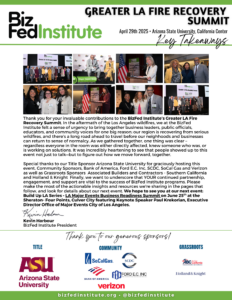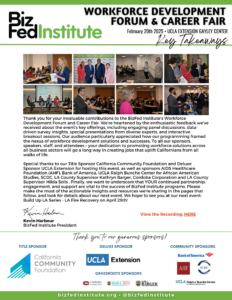Here’s a Rundown …

Panel 1 Moderator Matt Horton, Milken Institute:Successful Policies in Other Cities

· Nikia Clark, San Diego Regional EDC
We need to recognize the need for economic development within the business community to create jobs and understand how that drives the need for housing development. There needs to be a regional commitment to the growth in workers’ skillset that in turn drives the ability to afford the new homes being built.
· Mike Hansen, City of San Diego Planning Dept.
We need a plan that motivates elected officials to support housing development and then the general public needs to show up to vote for the plan that motivates the elected. We need to address inhibitors like the time it takes to process building permits since the goals to build are very high. Diversified/creative approach to building needed.
· Chris Gray, Western Riverside COG
There are 2 million people in Riverside County that commute to surrounding counties to work probably because they can’t afford to love there. Riverside has a 200,000 unit backlog in housing production. Also, due to unaffordability, a Regional Housing Land Trust was formed to drive down the cost of building housing which can be passed down to the buyer or renter. Public land is a key component to making the Land Trust viable and that land will be mapped out for a pipeline.
· Denny Zane, MoveLA
Santa Monica has done a great job of getting housing built with a third of them affordable based on neighborhood median income. This required the voters to enact that 30% of the new builds be affordable. There is a requirement for us to consider building housing close to jobs and on transit corridors and maps were shown of transit corridors in LA County that supports this idea. Public money will be needed to keep the price downPanel 2 Moderator Steve Pontell, National CORE: Regional Housing Solutions

· Jonathan Woetzel, McKinsey & Co.
There is a $50B housing affordability gap that impacts construction, jobs, income and at the end of the day affects us all regarding lost revenue including the state. There are mandates to build as 60,000 units of housing (up from 6,000) which means we have to look at all forms of housing including ADU’s. Cities need to take control and be involved in financial modeling (incentives) from end to end.
· Miguel Santana, Pomona Fairplex
There is a need for predictability when assessing how to reach our housing goals and elected officials are one of the biggest barriers. We must break and remake the system by removing market rate vs. affordable housing competition. We need help from outside the system in terms of incentives and funding to help lower the costs to build. There also needs to be government accountability starting with the Governor, Speaker, and Senate ProTem.
· Ben Metcalf, Terner Center
We need to build more affordable housing as soon as possible and make better housing levels if we’re going to win this battle and ake a dent in the problem. There needs to be a comprehensive Economic Development Strategy in order to permanently solve this problem and get us headed in the right direction.
· Cecilia Estolano, Estolano Advisors
SCAG started out wanting to make a contribution to help the SoCal Regional Counties reach their aggressive RHNA goals. When COVID-19 hit it threw everything askew as staff (slowed down permit process) and funds (slowed construction)were redirected to deal with this pandemic. The Regional Early Action Program ($40M) was awarded to SCAG to help fill the gap by using consultants to do reviews and permit processing. SCAG did research on best practices for zoning, assessed ADU viability and playing a bigger role in evaluating how to streamline the financing process. SCAG also realized that local governments were incapable of resisting NIMBY’s when it came to using CEQA to stall developments.Panel 3 Moderator Tracy Hernandez, BizFed: Elected Officials Vision on Building More Housing

· Hon. Anthony Portantino, California State Senate
We need to create economic incentives to re-purpose commercial buildings and vacant land. SB 1299 needs to be re-introduced in 2021 to address the issues around housing development. Many cities (NIMBY) have been resistant to building new housing, but many are now ready to partner with the state to get more incentives to lower costs. We need to streamline CEQA, rezone certain areas, so we can provide workforce housing. Then there must be accountability for the cities to get this done now.
· Hon. Miguel Santiago, California State Assembly
There must be immediate CEQA exemptions for housing development, but the problem is that the momentum to get this done was stalled due to COVID-19. There are also NIMBY issues while the YIMBY is trying to move forward while needing tools (zoning, schools, municipal land, funding) to get it done. There is also the realization and need for a flexible approach as there is no “one size fits all” for a statewide strategy. We must be creative with in-fill affordable, retail conversion, and other creative ideas framed in 30 days or less for zoning approvals. Lastly, accountability is required with deadlines to fix inhibitors.
· Hon. Terry Tornek, Mayor of Pasadena,
Issues are so politically contentious that it paralyzes local officials. Once an issue gets too big, there is push back on solving it. A case and point is how Nimby’s are weaponizing CEQA to stall developments that drive up costs to an unacceptable level. This, along with overly aggressive goals to build housing (7x’s the current rate) which is virtually unachievable. Pasadena built thousands of market-rate and hundreds of affordable due to community-based organizations pushing the needle 15%-20% with the help of city-owned land and churches
· Hon. Kathryn Barger, LA County Supervisor
Homelessness is still an issue lin lieu of HHH with no immediate and easy solutions in sight to lower the cost of building on a per-unit cost basis. Nimby was weaponized CEQA and reform must take place. Middle-class families need to be able to afford housing (which they can’t currently) or they will continue moving out of state. If we build affordable housing along transit corridors and hubs people will buy or rent them. Regionally, North LA County is a viable option to help solve the problem with the emergence of telework.

Closing Remark/Takeaways: Kevin Klowden, Milken Institute>Cities must endeavor to create public policy and processes that incentivize developers without giving them too much power.> How do we differentiate good vs. bad cities in terms of meeting mandates. The solution might be to award funds to cities that embrace and cooperate with building affordable housing.

Keeping you informed,
Kevin Harbour
President, BizFed Institute




